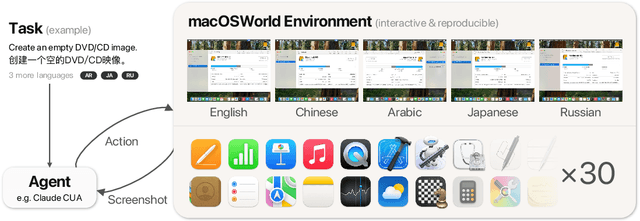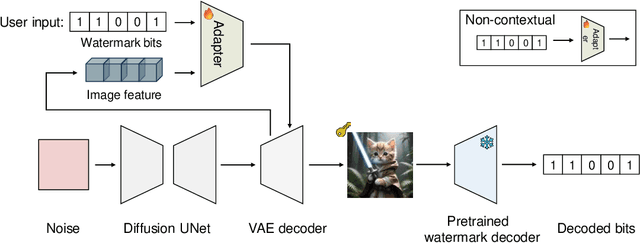Pei Yang
H2R-Grounder: A Paired-Data-Free Paradigm for Translating Human Interaction Videos into Physically Grounded Robot Videos
Dec 10, 2025Abstract:Robots that learn manipulation skills from everyday human videos could acquire broad capabilities without tedious robot data collection. We propose a video-to-video translation framework that converts ordinary human-object interaction videos into motion-consistent robot manipulation videos with realistic, physically grounded interactions. Our approach does not require any paired human-robot videos for training only a set of unpaired robot videos, making the system easy to scale. We introduce a transferable representation that bridges the embodiment gap: by inpainting the robot arm in training videos to obtain a clean background and overlaying a simple visual cue (a marker and arrow indicating the gripper's position and orientation), we can condition a generative model to insert the robot arm back into the scene. At test time, we apply the same process to human videos (inpainting the person and overlaying human pose cues) and generate high-quality robot videos that mimic the human's actions. We fine-tune a SOTA video diffusion model (Wan 2.2) in an in-context learning manner to ensure temporal coherence and leveraging of its rich prior knowledge. Empirical results demonstrate that our approach achieves significantly more realistic and grounded robot motions compared to baselines, pointing to a promising direction for scaling up robot learning from unlabeled human videos. Project page: https://showlab.github.io/H2R-Grounder/
Exploring Diffusion with Test-Time Training on Efficient Image Restoration
Jun 17, 2025Abstract:Image restoration faces challenges including ineffective feature fusion, computational bottlenecks and inefficient diffusion processes. To address these, we propose DiffRWKVIR, a novel framework unifying Test-Time Training (TTT) with efficient diffusion. Our approach introduces three key innovations: (1) Omni-Scale 2D State Evolution extends RWKV's location-dependent parameterization to hierarchical multi-directional 2D scanning, enabling global contextual awareness with linear complexity O(L); (2) Chunk-Optimized Flash Processing accelerates intra-chunk parallelism by 3.2x via contiguous chunk processing (O(LCd) complexity), reducing sequential dependencies and computational overhead; (3) Prior-Guided Efficient Diffusion extracts a compact Image Prior Representation (IPR) in only 5-20 steps, proving 45% faster training/inference than DiffIR while solving computational inefficiency in denoising. Evaluated across super-resolution and inpainting benchmarks (Set5, Set14, BSD100, Urban100, Places365), DiffRWKVIR outperforms SwinIR, HAT, and MambaIR/v2 in PSNR, SSIM, LPIPS, and efficiency metrics. Our method establishes a new paradigm for adaptive, high-efficiency image restoration with optimized hardware utilization.
macOSWorld: A Multilingual Interactive Benchmark for GUI Agents
Jun 05, 2025



Abstract:Graphical User Interface (GUI) agents show promising capabilities for automating computer-use tasks and facilitating accessibility, but existing interactive benchmarks are mostly English-only, covering web-use or Windows, Linux, and Android environments, but not macOS. macOS is a major OS with distinctive GUI patterns and exclusive applications. To bridge the gaps, we present macOSWorld, the first comprehensive benchmark for evaluating GUI agents on macOS. macOSWorld features 202 multilingual interactive tasks across 30 applications (28 macOS-exclusive), with task instructions and OS interfaces offered in 5 languages (English, Chinese, Arabic, Japanese, and Russian). As GUI agents are shown to be vulnerable to deception attacks, macOSWorld also includes a dedicated safety benchmarking subset. Our evaluation on six GUI agents reveals a dramatic gap: proprietary computer-use agents lead at above 30% success rate, while open-source lightweight research models lag at below 2%, highlighting the need for macOS domain adaptation. Multilingual benchmarks also expose common weaknesses, especially in Arabic, with a 27.5% average degradation compared to English. Results from safety benchmarking also highlight that deception attacks are more general and demand immediate attention. macOSWorld is available at https://github.com/showlab/macosworld.
In-Context Defense in Computer Agents: An Empirical Study
Mar 12, 2025Abstract:Computer agents powered by vision-language models (VLMs) have significantly advanced human-computer interaction, enabling users to perform complex tasks through natural language instructions. However, these agents are vulnerable to context deception attacks, an emerging threat where adversaries embed misleading content into the agent's operational environment, such as a pop-up window containing deceptive instructions. Existing defenses, such as instructing agents to ignore deceptive elements, have proven largely ineffective. As the first systematic study on protecting computer agents, we introduce textbf{in-context defense}, leveraging in-context learning and chain-of-thought (CoT) reasoning to counter such attacks. Our approach involves augmenting the agent's context with a small set of carefully curated exemplars containing both malicious environments and corresponding defensive responses. These exemplars guide the agent to first perform explicit defensive reasoning before action planning, reducing susceptibility to deceptive attacks. Experiments demonstrate the effectiveness of our method, reducing attack success rates by 91.2% on pop-up window attacks, 74.6% on average on environment injection attacks, while achieving 100% successful defenses against distracting advertisements. Our findings highlight that (1) defensive reasoning must precede action planning for optimal performance, and (2) a minimal number of exemplars (fewer than three) is sufficient to induce an agent's defensive behavior.
Partial Distribution Alignment via Adaptive Optimal Transport
Mar 07, 2025Abstract:To remedy the drawbacks of full-mass or fixed-mass constraints in classical optimal transport, we propose adaptive optimal transport which is distinctive from the classical optimal transport in its ability of adaptive-mass preserving. It aims to answer the mathematical problem of how to transport the probability mass adaptively between probability distributions, which is a fundamental topic in various areas of artificial intelligence. Adaptive optimal transport is able to transfer mass adaptively in the light of the intrinsic structure of the problem itself. The theoretical results shed light on the adaptive mechanism of mass transportation. Furthermore, we instantiate the adaptive optimal transport in machine learning application to align source and target distributions partially and adaptively by respecting the ubiquity of noises, outliers, and distribution shifts in the data. The experiment results on the domain adaptation benchmarks show that the proposed method significantly outperforms the state-of-the-art algorithms.
SpecDM: Hyperspectral Dataset Synthesis with Pixel-level Semantic Annotations
Feb 24, 2025Abstract:In hyperspectral remote sensing field, some downstream dense prediction tasks, such as semantic segmentation (SS) and change detection (CD), rely on supervised learning to improve model performance and require a large amount of manually annotated data for training. However, due to the needs of specific equipment and special application scenarios, the acquisition and annotation of hyperspectral images (HSIs) are often costly and time-consuming. To this end, our work explores the potential of generative diffusion model in synthesizing HSIs with pixel-level annotations. The main idea is to utilize a two-stream VAE to learn the latent representations of images and corresponding masks respectively, learn their joint distribution during the diffusion model training, and finally obtain the image and mask through their respective decoders. To the best of our knowledge, it is the first work to generate high-dimensional HSIs with annotations. Our proposed approach can be applied in various kinds of dataset generation. We select two of the most widely used dense prediction tasks: semantic segmentation and change detection, and generate datasets suitable for these tasks. Experiments demonstrate that our synthetic datasets have a positive impact on the improvement of these downstream tasks.
IDProtector: An Adversarial Noise Encoder to Protect Against ID-Preserving Image Generation
Dec 16, 2024



Abstract:Recently, zero-shot methods like InstantID have revolutionized identity-preserving generation. Unlike multi-image finetuning approaches such as DreamBooth, these zero-shot methods leverage powerful facial encoders to extract identity information from a single portrait photo, enabling efficient identity-preserving generation through a single inference pass. However, this convenience introduces new threats to the facial identity protection. This paper aims to safeguard portrait photos from unauthorized encoder-based customization. We introduce IDProtector, an adversarial noise encoder that applies imperceptible adversarial noise to portrait photos in a single forward pass. Our approach offers universal protection for portraits against multiple state-of-the-art encoder-based methods, including InstantID, IP-Adapter, and PhotoMaker, while ensuring robustness to common image transformations such as JPEG compression, resizing, and affine transformations. Experiments across diverse portrait datasets and generative models reveal that IDProtector generalizes effectively to unseen data and even closed-source proprietary models.
Anti-Reference: Universal and Immediate Defense Against Reference-Based Generation
Dec 08, 2024Abstract:Diffusion models have revolutionized generative modeling with their exceptional ability to produce high-fidelity images. However, misuse of such potent tools can lead to the creation of fake news or disturbing content targeting individuals, resulting in significant social harm. In this paper, we introduce Anti-Reference, a novel method that protects images from the threats posed by reference-based generation techniques by adding imperceptible adversarial noise to the images. We propose a unified loss function that enables joint attacks on fine-tuning-based customization methods, non-fine-tuning customization methods, and human-centric driving methods. Based on this loss, we train a Adversarial Noise Encoder to predict the noise or directly optimize the noise using the PGD method. Our method shows certain transfer attack capabilities, effectively challenging both gray-box models and some commercial APIs. Extensive experiments validate the performance of Anti-Reference, establishing a new benchmark in image security.
Steganalysis on Digital Watermarking: Is Your Defense Truly Impervious?
Jun 13, 2024Abstract:Digital watermarking techniques are crucial for copyright protection and source identification of images, especially in the era of generative AI models. However, many existing watermarking methods, particularly content-agnostic approaches that embed fixed patterns regardless of image content, are vulnerable to steganalysis attacks that can extract and remove the watermark with minimal perceptual distortion. In this work, we categorize watermarking algorithms into content-adaptive and content-agnostic ones, and demonstrate how averaging a collection of watermarked images could reveal the underlying watermark pattern. We then leverage this extracted pattern for effective watermark removal under both graybox and blackbox settings, even when the collection contains multiple watermark patterns. For some algorithms like Tree-Ring watermarks, the extracted pattern can also forge convincing watermarks on clean images. Our quantitative and qualitative evaluations across twelve watermarking methods highlight the threat posed by steganalysis to content-agnostic watermarks and the importance of designing watermarking techniques resilient to such analytical attacks. We propose security guidelines calling for using content-adaptive watermarking strategies and performing security evaluation against steganalysis. We also suggest multi-key assignments as potential mitigations against steganalysis vulnerabilities.
WMAdapter: Adding WaterMark Control to Latent Diffusion Models
Jun 12, 2024



Abstract:Watermarking is crucial for protecting the copyright of AI-generated images. We propose WMAdapter, a diffusion model watermark plugin that takes user-specified watermark information and allows for seamless watermark imprinting during the diffusion generation process. WMAdapter is efficient and robust, with a strong emphasis on high generation quality. To achieve this, we make two key designs: (1) We develop a contextual adapter structure that is lightweight and enables effective knowledge transfer from heavily pretrained post-hoc watermarking models. (2) We introduce an extra finetuning step and design a hybrid finetuning strategy to further improve image quality and eliminate tiny artifacts. Empirical results demonstrate that WMAdapter offers strong flexibility, exceptional image generation quality and competitive watermark robustness.
 Add to Chrome
Add to Chrome Add to Firefox
Add to Firefox Add to Edge
Add to Edge